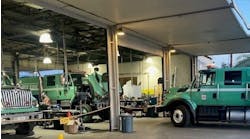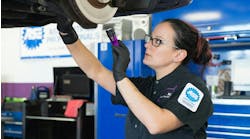This is Part Three of a three-part series. Read Part 1 here. Read Part 2 here.
In the 2023 American Transportation Resesarch Institute's Analysis of the Operational Costs of Trucking, fleets reported that that 2022 average cost per mile for tire maintenance was 4.5 cents per mile. While that might not seem like much, that means the responding fleets spent almost $1.4 million on tires throughout the 13.6 billion miles they drove. And in 2023, the ATRI found that tire expenses are only increasing.
To cut down on these costs and maximize a tire program's and fuel efficiency, fleets need to have a good benchmark on how effective their program actually is and how much money it's saving them. In Part One of this story, we discussed how fleets can analyze their tire pressure and duty cycle to minimize tire costs, while Part Two covered how inspections and record-keeping can help indicate whether or not a program is working. Various digital programs can help give fleets these answers as a part of a holistic approach to tire management.
Tracking solutions
Valentino Faraone III, regional vice president, new product development manager, Double Coin, pointed out that a fleet’s dealer partners can be valuable assets when it comes to effective tire maintenance. “They not only assist fleets in managing their tire programs but also allow maintenance personnel to focus on other projects that need their attention and time,” he said.
Digital tire management solutions can help fleets get more out of their tires, noted Jim Garrett, product category manager, Michelin North America. “These tools lead to having better tire maintenance management practices that can help drive down costs and reduce tire-related expenses, particularly road failures,” he said.
Michelin offers a digital tire management approach through solutions that encompass connected platforms and provide fleets with a network of partners (OEMs, distributors, equipment suppliers, etc.) and access to a range of services. The manufacturer also leverages data to provide recommendations that enable fleets to make more informed tire decisions, Garrett noted.
Read more: Tiremakers roll out new tech at CES 2024
“Whether it’s through improved tire pressure monitoring, adherence to tread depth pull points, or better analyses,” Garrett said, “our goal is to help fleets improve their tire maintenance and management practices by providing them with better tools and data.”
Continental’s digital tire monitoring systems include ContiConnect, a management platform that collects continuous tire pressure and temperature data. “With tire sensors and software, ContiConnect enables fleets to digitally capture and monitor the mileage, tread depth, and condition of all tires in the fleet,” explained Shaun Uys, vice president, Truck Tires U.S., Continental.
These tire data platforms also connect to fleet management systems for more visibility. For instance, Pressure Systems International (P.S.I.) TireView LIVE can now be accessed directly though Geotab Use Interface by connecting a few harnesses. The ability to analyze tire data allows fleets to better understand root causes, noted Craig Smith, P.S.I.’s VP of marketing.
By integrating mobile data capture technology and tire tread scanning platforms, fleets can more efficiently gather and analyze the necessary information for key tire metrics, noted Chris Garcia, head of U.S. automotive business, Anyline.
Specifically, Anyline offers a Tire Sidewall Scanner, Tire Tread Scanner, and capabilities for insight and integration with existing fleet management systems. The company’s technology can scan and interpret tire identification numbers (TIN and DOT), tire sizes, and tire tread and wear.
Adding up savings
Uys said there are major areas of waste that can cause fleets to incur higher tire expenses. Along with keeping up with air pressures, vehicle maintenance for items like proper alignment, as well as spec’ing the correct tires and retreading, will all help address that challenge.
Taking a comprehensive approach to fleet management significantly cuts tire-related expenses, optimizing both direct and indirect costs.
“Proper tire management starts with the correct specification of tires,” Garcia said. “Using the wrong tire for the operating environment and/or application can lead to premature tire wear and drive costs higher. Not only will tires wear out faster, leading to the need to purchase more new tires, but there is also a direct impact on fuel economy and fleet safety.”
Not paying attention to tires means losing cash out of your pocket, noted Michelin’s Garrett. “By making sure your tires are as efficient as possible, you can save serious money, and give your fleet a real competitive advantage,” he said.





